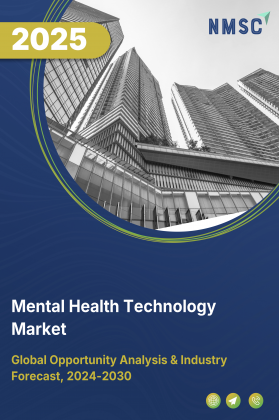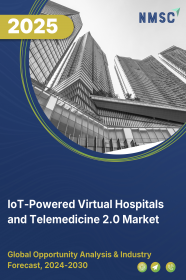
Mental Health Technology Market by Product Type (Software, Services), by Technology (Artificial Intelligence, Others), by Mental Health Condition (Depression, , Others), by Age Group (Teenagers, Others), by Revenue Model (Subscription-Based, Others), by Delivery Mode (Cloud-Based, Others), by Distribution Channel (App Stores, Others), by Application (Screening and Assessment, Others), by End User (Individuals, Hospital, Others) – Global Opportunity Analysis and Forecast, 2025–2030
Industry Overview
The global Mental Health Technology Market size was valued at USD 10.91 billion in 2024, and is expected to be valued at USD 12.98 billion by the end of 2025. The industry is projected to grow, hitting USD 30.97 billion by 2030, with a CAGR of 19.0% between 2025 and 2030.
The market is witnessing rapid growth, driven by the rising prevalence of mental health disorders, critical shortages of professionals, and increasing public awareness. Scalable digital tools, such as mobile apps, AI chatbots, and teletherapy platforms are addressing urgent needs for accessible, cost-effective care, especially in underserved regions.
Government initiatives like India’s Tele MANAS app highlight growing institutional support. While demand accelerates, concerns over data privacy and security pose adoption barriers, particularly in regions with strong regulatory frameworks.
Nevertheless, the expanding integration of mental health tech into clinical settings presents substantial opportunities, as hospitals and healthcare providers increasingly adopt digital tools for diagnosis, treatment, and patient engagement, further strengthening the market outlook.
Escalating Global Mental Health Disorders Driving Market Trends
The rising global burden of mental health disorders is a primary driver of the mental health technology growth. According to the Ministry of Health & Family Welfare in 2025, 15% of India’s adult population experiences mental health issues requiring intervention. Depression is a leading cause of disability globally, underscoring the urgent need for scalable interventions.
Mobile apps, AI chatbots, and digital platforms address this widespread unmet need by providing immediate support to millions. For instance, the Tele MANAS app, launched by the Indian government in 2024, offers 24/7 remote access to mental health resources, including self-care tools and direct consultations, addressing the high prevalence in the region.
Critical Shortage of Mental Health Professionals Fuels Technology Adoption
The growing global shortfall of mental health professionals is a key catalyst for the rising adoption of digital mental health solutions. According to the National Library of Medicine in 2025, the world faces a shortage of over 5 million mental health providers, significantly straining access to timely and effective care. This gap is particularly acute in underserved and remote regions, where psychiatrists, psychologists, and licensed therapists are scarce.
In response, technologies such as AI-powered chatbots, virtual therapy platforms, and mental health apps are stepping in to bridge the service gap. These tools offer scalable, on-demand support, reducing wait times and removing geographic barriers, while providing cost-effective access to mental healthcare for broader populations.
Rising Public Awareness Drives Mental Health Technology Adoption
Rising public awareness of mental health issues is a key driver accelerating the adoption of technology-based mental health solutions. Increased media coverage, advocacy campaigns, and education initiatives have helped normalize discussions around mental well-being, encouraging more individuals to acknowledge symptoms and seek support.
As mental health becomes a recognized priority across all age groups, especially among younger, tech-savvy populations, there is a growing demand for accessible, stigma-free, and private tools such as mental health apps, digital therapy platforms, and virtual support groups. This heightened awareness not only fuels user adoption but also motivates policymakers, employers, and healthcare providers to invest in and integrate digital mental health solutions more broadly.
Concerns over Data Privacy and Security Hindering Mental Health Technology Market Expansion
Growing concerns over data privacy and security are increasingly acting as key barriers to the adoption of mental health technologies. According to Pew Research Center in 2025, 73% of U.S. adults have encountered some form of online scam or cyberattack, highlighting a widespread exposure to digital threats across all age groups. This environment of heightened digital vulnerability amplifies user scepticism when it comes to sharing sensitive mental health and personal data through apps and online platforms.
Worries about data breaches, unauthorized access, and potential misuse of psychological records are compounded by insufficient transparency in data practices, weak regulatory safeguards, and inconsistent cybersecurity standards. As a result, user trust is eroded, which may hinder engagement and slow the integration of digital mental health tools, especially in regions with strong data protection norms or high public awareness around privacy issues.
Expanding Adoption of Mental Health Tech in Clinical Settings Unlocks Growth Opportunities
The increasing integration of mental health technologies into hospitals and clinics presents a strong growth opportunity for the market. Healthcare providers are actively seeking digital tools, such as teletherapy platforms, mental health apps, and AI-based assessment tools to support early diagnosis, personalized treatment, and continuous monitoring of mental health conditions.
As mental health becomes a greater priority in overall patient care, these technologies are being adopted to enhance service delivery, reduce clinician burden, and expand access to care. This shift toward tech-enabled mental healthcare within mainstream clinical settings opens new channels for adoption, funding, and long-term partnerships across the healthcare ecosystem.
Market Segmentation and Scope of the Study
The mental health technology market report is segmented by product type, technology, mental health condition, age, revenue model, delivery mode, distribution channel, application, end user, and region. On the basis of component, the market is classified into hardware, software and services. On the basis of application, the market is divided mental health screening and assessment, therapy and treatment, self-management and support and others. Based on end user, the market is categorized into hospital, educational institution and others. Regionally, the market is evaluated across North America, Europe, Asia Pacific, and the rest of the world.
Geographical Analysis
North America's advanced healthcare infrastructure and rapid integration of digital tools continue to propel the mental health technology market share. A critical enabler is the region's near-universal internet access, as of 2024, 96% of U.S. adults report using the internet, according to Pew Research Center. This high connectivity rate supports widespread use of teletherapy platforms, mental wellness apps, and AI-driven mental health solutions.
Coupled with favourable government policies, strong investment in digital health innovation, and growing public awareness around mental health, the environment is highly conducive to the expansion of accessible, tech-enabled mental health services across the U.S. and Canada.
In Europe, strong government backing and evolving mental health policies are driving the growth of the mental health technology market. Many countries across the region are prioritizing mental health within their national healthcare strategies, promoting the use of digital solutions like online therapy platforms, mobile mental wellness apps, and remote monitoring tools. Public funding, regulatory support for digital therapeutics, and national awareness campaigns have encouraged both adoption and innovation, making Europe a key region for the expansion of mental health technologies.
An alarming rise in mental health challenges among youth in the Asia-Pacific region is fuelling the demand for technology-driven mental health solutions. Increasing academic pressure, social media use, urban stress, and changing family dynamics have contributed to heightened anxiety, depression, and emotional distress among adolescents and young adults.
As a result, there's a growing shift toward mobile mental wellness apps, online therapy, and self-help platforms that offer privacy, convenience, and culturally relevant support. This trend is pushing both private and public stakeholders to invest in youth-focused mental health tech across countries like Japan, India, South Korea, and Indonesia.
In many low- and middle-income countries, the expansion of mental health technology is being significantly driven by targeted funding and programmatic support from global health institutions such as the WHO and UNICEF. Notably, in October 2024, these organizations released joint service guidelines aimed at improving access to mental health care for children and adolescents.
The guidelines specifically encourage the use of community and school-based digital interventions, highlighting the role of technology in bridging service gaps. This global push has accelerated the deployment of telepsychiatry platforms, mobile wellness apps, and SMS-based tools in regions affected by poverty, conflict, or humanitarian crises, areas where conventional mental health infrastructure is often lacking. Such efforts are not only enhancing accessibility but also building awareness and integration of mental health support into national public health strategies.
Strategic Innovations Adopted by Key Players
Key players in the mental health technology industry are actively advancing the sector through AI-driven innovations, personalized digital platforms, and strategic partnerships.
-
In June 2025, BetterHelp partnered with three WNBA teams (New York Liberty, Las Vegas Aces, Dallas Wings) as official mental health partner, promoting wellness initiatives.
-
In April 2025, Spring Health introduced VERA‑MH, an open industry benchmark for ethical and clinically rigorous AI in mental health care.
-
In January 2025, Cerebral partnered with the San Antonio Spurs to raise mental health awareness, delivering workshops and advocacy through the team’s community initiatives.
-
In November 2024, Wysa launched Wysa Copilot, a hybrid AI-human therapy platform now used in the UK’s NHS Talking Therapy services.
-
In October 2024, Headspace introduced Ebb, an empathetic AI companion in its app that supports users through personalized conversations and content recommendations based on emotional state.
Key Benefits
-
The report provides quantitative analysis and estimations of the industry from 2025 to 2030, which assists in identifying the prevailing market opportunities.
-
The study comprises a deep dive analysis of the current and future mental health technology market trends to depict prevalent investment pockets in the sector.
-
Information related to key drivers, restraints, and opportunities and their impact on the market is provided in the report.
-
Competitive analysis of the players, along with their market share, is provided in the report.
-
SWOT analysis and Porter's Five Forces model are elaborated in the study.
-
Value chain analysis in the market study provides a clear picture of the roles of stakeholders.
Mental Health Technology Market Key Segments
By Product Type
-
Hardware
-
Wearables
-
Virtual Reality (VR) Headsets
-
Augmented Reality (AR) Devices
-
Smart Rings and Bracelets
-
-
Neurofeedback Devices
-
Biofeedback Devices
-
Brain Stimulation Devices
-
-
Software/Platform
-
Electronic Health Records (EHR) Systems
-
Telehealth Platforms
-
Mobile Applications
-
Meditation and Mindfulness Apps
-
Cognitive Behavioral Therapy (CBT) Apps
-
Mood Tracking Apps
-
Self-Help and Coping Apps
-
-
Clinical Decision Support Systems
-
Practice Management Software
-
Patient Engagement Platforms
-
Data Analytics and Reporting Tools
-
Others
-
-
Services
-
Teletherapy Services
-
Online Counselling Services
-
Psychiatric Consultation Services
-
Subscription-Based Support Services
-
Training and Implementation Services
-
By Technology
-
Artificial Intelligence (AI) and Machine Learning (ML)
-
Telemedicine
-
Internet of Things (IoT)
-
Big Data Analytics
-
Cloud Computing
-
Blockchain
-
Others
By Mental Health Condition
-
Depression
-
Anxiety Disorders
-
Generalized Anxiety Disorder
-
Social Anxiety Disorder
-
Panic Disorder
-
-
Post-Traumatic Stress Disorder (PTSD)
-
Bipolar Disorder
-
Schizophrenia
-
Obsessive-Compulsive Disorder (OCD)
-
Substance Abuse and Addiction
-
Attention Deficit Hyperactivity Disorder (ADHD)
-
Autism Spectrum Disorder (ASD)
-
Eating Disorders
-
Insomnia and Sleep Disorders
-
Others
By Age
-
Teenagers
-
Adults
-
Geriatric / Seniors
By Revenue Model
-
Subscription-Based
-
Pay-Per-Use
-
License-Based
-
Advertising-Based
-
Value-Based Pricing
By Delivery Mode
-
Cloud-Based
-
On-Premise
-
Hybrid
By Distribution Channel
-
App Stores
-
Online Platforms
-
Others
By Application
-
Mental Health Screening and Assessment
-
Therapy and Treatment
-
Self-Management and Support
-
Clinical Support
-
Education and Training
-
Workplace Wellness
-
Crisis Intervention
-
Chronic Condition Management
-
Others
By End User
-
Individuals
-
Hospitals/Clinics
-
Employers
-
Educational Institutions
-
Government and Non-Governmental Organizations (NGOs)
-
Research Institutions
-
Community Health Centers
-
Others
By Region
-
North America
-
The U.S.
-
Canada
-
Mexico
-
-
Europe
-
The UK
-
Germany
-
France
-
Italy
-
Spain
-
Denmark
-
Netherlands
-
Finland
-
Sweden
-
Norway
-
Russia
-
Rest of Europe
-
-
Asia-Pacific
-
China
-
Japan
-
India
-
South Korea
-
Australia
-
Indonesia
-
Singapore
-
Taiwan
-
Thailand
-
Rest of Asia-Pacific
-
-
RoW
-
Latin America
-
Middle East
-
Africa
-
Key Players
-
Talkspace
-
Lyra Health
-
Spring Health
-
Netsmart Technologies Inc.
-
Shezlong
-
Myndgard
-
Cerebral
-
BetterHelp
-
Kintsugi
-
PsyOmics
-
Wysa
-
Healios Ltd.
-
Feel Therapeutics Inc
REPORT SCOPE AND SEGMENTATION:
|
Parameters |
Details |
|
Market Size in 2025 |
USD 12.98 Billion |
|
Revenue Forecast in 2030 |
USD 30.97 Billion |
|
Growth Rate |
CAGR of 19.0% from 2025 to 2030 |
|
Analysis Period |
2024–2030 |
|
Base Year Considered |
2024 |
|
Forecast Period |
2025–2030 |
|
Market Size Estimation |
Billion (USD) |
|
Growth Factors |
|
|
Countries Covered |
28 |
|
Companies Profiled |
15 |
|
Market Share |
Available for 10 companies |
|
Customization Scope |
Free customization (equivalent up to 80 working hours of analysts) after purchase. Addition or alteration to country, regional, and segment scope. |
|
Pricing and Purchase Options |
Avail customized purchase options to meet your exact research needs. |

















 Speak to Our Analyst
Speak to Our Analyst

























